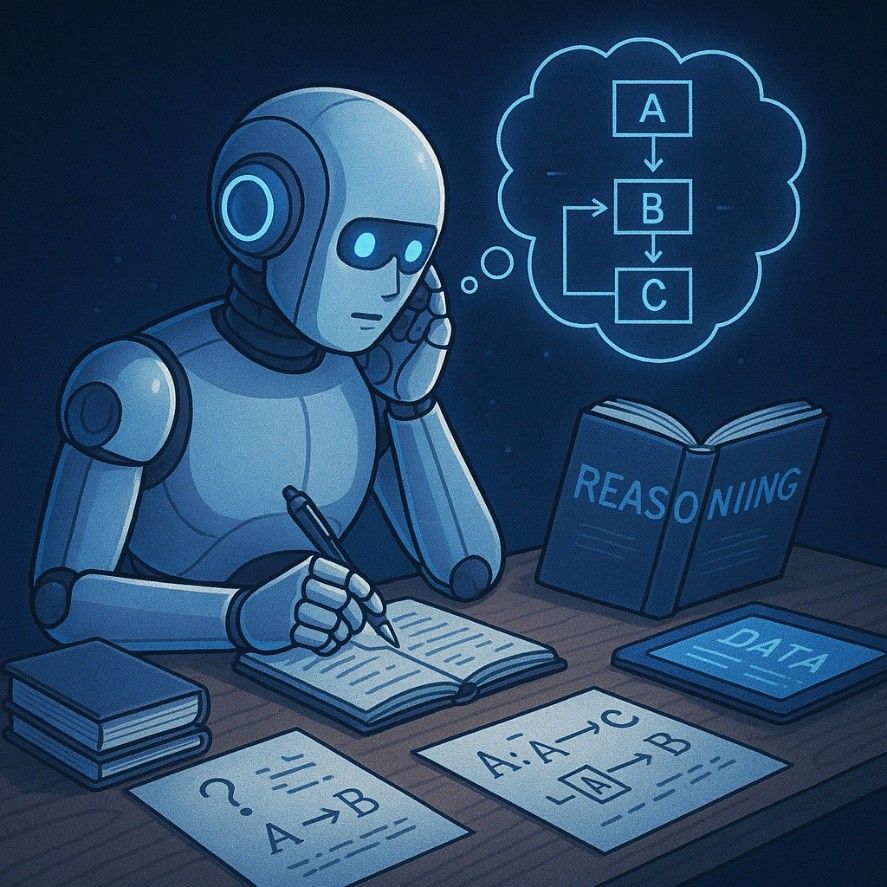The Challenge of Reasoning
Large Language Models (LLMs) have dramatically altered the landscape of artificial intelligence, showcasing impressive abilities to understand and generate language that sounds remarkably human [2]. Their fluency and capacity to handle intricate language-based tasks have positioned them as foundational components for the future of Artificial General Intelligence (AGI). However, despite their linguistic prowess, a significant gap remains between their skills in language and genuine reasoning abilities.
While an LLM can produce incredibly convincing text, a critical question arises: can it genuinely think through a problem like a human? [4]. According to epistemology, the philosophy concerned with knowledge, reasoning is defined as the ability to draw inferences from evidence or premises. This capacity is fundamental for humans to acquire knowledge and make informed decisions. While this process is natural for us, replicating true reasoning in language models has proven challenging [4].
Early models like GPT-3 demonstrated basic reasoning and the ability to follow instructions, capabilities that were significantly advanced in subsequent versions such as ChatGPT and later generation models [1]. A key technique that further boosted performance was the introduction of chain-of-thought prompting [4]. This method allows models to decompose complex problems into smaller, more manageable steps. The success of this technique even led to exciting claims that GPT-4 was showing “sparks of AGI [2].
Upon closer inspection, however, research suggests that although LLMs can emulate reasoning on specific tasks, they do not necessarily reason truly like humans without additional guidance [3, 4, 5]. For example, solving a complex mathematical theorem typically requires breaking down the problem and iteratively refining a solution – a process that LLMs often struggle with when left to their own devices. This realization has directed research efforts toward developing innovative techniques specifically aimed at evoking genuine reasoning, moving beyond simply increasing the size of the models. Interestingly, some newer models with fewer parameters have occasionally outperformed much larger ones on reasoning tasks, indicating that there are potentially more effective ways to improve reasoning than merely scaling up model size [7].
As Henry Ford famously stated, “Thinking is the hardest work there is, which is probably why so few engage in it.” For artificial intelligence, mastering this “hardest work” is paramount as it has been progressing since foundational transformers [6]. Reasoning is far more than just solving puzzles; it is essential for complex problem-solving across a wide variety of domains. Furthermore, it is a necessary step toward building trust in AI systems, which is critical for their safe and reliable deployment in sensitive sectors such as healthcare, banking, law, defense, and security. With powerful new models focused on reasoning now emerging, this capability has become a central topic in LLM research.
So, how exactly are researchers attempting to imbue these powerful language models with the ability to reason? There are three primary approaches being explored: Reinforcement Learning, Test Time Compute, and Self-Training Methods. These three paradigms represent different strategies for enhancing the reasoning capabilities of large language models.

Pillars of LLM Reasoning
Reinforcement Learning: Learning by Doing and Getting Feedback
At its core, reinforcement learning (RL) is a method for training an agent to interact with an environment to maximize a cumulative reward. This can be visualized like teaching a computer to play a game: the agent takes an action, the environment (the game) provides a response, and the agent receives a score or reward. Through this process, the computer learns over time which actions lead to higher scores.
In the context of LLMs, the language model itself acts as the agent [8]. Its “actions” can involve generating the next word or sequence of words, representing a step within a potential reasoning process. The “environment” could be an external tool, another AI model, or even the LLM interacting with itself. This environment provides feedback, frequently in the form of a reward signal. The LLM learns to choose actions (generating specific text sequences) that lead to better outcomes, effectively learning an “optimal policy” or strategy for reasoning. This process helps the model identify and follow paths of intermediate steps – its reasoning process – that lead to a desired goal.
RL strategies applied to LLMs can be categorized further based on the nature of the feedback provided [8].
• Verbal Reinforcement: In this approach, the feedback is provided not just as a numerical score, but in natural language. The LLM generates a potential solution or a reasoning path. Other components of the system, which might include separate language models acting as an “Evaluator” or “Self-Reflector,” provide feedback using plain language. This feedback is stored, often in a memory component, and influences how the LLM generates text or reasoning steps in the future8 . Frameworks such as ReAct and Reflexion utilize this idea of verbal feedback to guide the model’s actions and thoughts [8].
• Reward-based Reinforcement: These methods employ more structured feedback, typically in the form of numerical rewards.
◦ Process Supervision: The model receives rewards for individual steps within its reasoning process. If an intermediate step is correct or helpful, it is assigned a positive reward, which guides the model towards constructing a coherent, step-by-step solution. While effective, obtaining detailed feedback for every single step can be difficult and expensive, often requiring labor-intensive human annotation.
◦ Outcome Supervision: Rewards are given only for the final outcome. If the model correctly answers a math problem, it receives a positive reward. If the answer is wrong, it receives a negative or zero reward.
• Search/Planning: These techniques draw inspiration from classical AI methods, utilizing algorithms like Monte Carlo Tree Search (MCTS). MCTS is a powerful search algorithm that explores potential future steps, similar to exploring possible moves in a game.
Test Time Compute: Boosting Intelligence at Inference Time
Normally, once a large language model has been trained, its internal parameters are fixed[1]. This characteristic can make it challenging for the model to adapt or reason effectively on novel, complex problems that it did not specifically encounter during its training phase. Test Time Compute (TTC) is a paradigm designed to address this limitation by applying additional computation during the inference phase (when the model is generating a response) to improve its reasoning capabilities, crucially without altering the model’s foundational training or weights.
Self-Training Methods: Learning from Your Own Best Thoughts
In contrast to Test Time Compute, which does not modify the core model, Self-Training Methods involve fine-tuning the pre-trained LLM using self-generated reasoning data. This process directly updates the model’s internal weights. This approach has led to significant improvements in reasoning performance.
The general principle behind these methods is to leverage the LLM’s existing capabilities to create training data that teaches it how to reason more effectively. This typically involves combining several techniques.
• Supervised Fine-Tuning (SFT): The model is initially fine-tuned on pairs of problems and their correct answers.
• Rejection Fine-Tuning: The model generates both a reasoning process and an answer for a given problem. This generated “thought process” is then used as training data only if the final answer is correct.
• Preference Tuning: The model generates multiple reasoning paths and answers for the same problems. These alternatives are compared, and a “preference dataset” is created. For instance, this dataset might indicate that one reasoning path is preferred over another because it successfully led to the correct answer. This preference data is subsequently used to fine-tune the model, encouraging it to generate the types of reasoning steps that result in accurate answers, often employing techniques like DPO.
Navigating the Obstacles
While these approaches demonstrate immense promise in enhancing LLM reasoning, the path toward achieving true reasoning capabilities is not without its hurdles. Automating the creation of detailed feedback for every step in a reasoning process (required for process supervision) remains challenging and often necessitates costly human efforts. Techniques like MCTS can be computationally expensive due to the vast number of possibilities they explore, sometimes even leading to “overthinking”. Obtaining fine-grained preference data for individual reasoning steps is also costly and can be subjective when compared to the simpler task of merely labeling a final answer as right or wrong.
Furthermore, the effectiveness of strategies that scale computation during inference (Test Time Compute) is ultimately limited by the quality of the initial pre-training. They cannot fully compensate for a weak base model when tackling truly difficult problems. Even well-known techniques like Chain-of-Thought prompting have been shown to be less effective, or even potentially harmful, for smaller LLMs.
Conclusion: The Dawn of Thinking Machines?
The ongoing efforts to equip Large Language Models with genuine reasoning are more than an academic pursuit; they are laying the groundwork for a new generation of intelligent tools for developers and society alike. The quest to endow Large Language Models with robust reasoning capabilities represents a critical step towards developing more intelligent and trustworthy AI systems [1][2][3]. For developers, this translates to more potent and reliable AI assistants capable of tackling intricate coding challenges, debugging with greater insight, and even contributing to innovative design processes.
Looking beyond the immediate applications for programmers, AI that can truly reason holds the potential to reshape how we interact with technology across all sectors. Imagine AI systems in healthcare that can diagnose with greater accuracy by reasoning through complex medical data, or financial tools that can foresee market shifts with deeper understanding. While the hurdles in automating feedback, optimizing computational demands, and ensuring data quality remain significant, the relentless progress in these three core areas—Reinforcement Learning, Test Time Compute, and Self-Training—signals a future where AI moves beyond fluent communication to insightful comprehension and effective problem-solving, ultimately becoming a more reliable and impactful force in our daily lives.
References
[1] Brown et al (2020). GPT-3. Language models are few-shot learners. Advances in neural information processing systems, 33, 1877-1901.
[2] OpenAI. (2023). GPT-4. Technical Report. https://cdn.openai.com/papers/gpt-4.pdf
[3] Ouyang et al (2022) Training language models to follow instructions with human feedback. Advances in Neural Information Processing Systems, 35, 27730-27744.
[4] Wei et al (2022). Chain-of-Thought Prompting Elicits Reasoning in Large Language Models. https://arxiv.org/abs/2201.11903
[5] Yao et al (2023). Tree of thoughts: Deliberate problem solving with large language models. https://arxiv.org/abs/2305.10601
[6] Vaswani et al (2017). Attention is all you need. Advances in neural information processing systems
[7] Jiang et al (2023). Mistral 7B and its Architecture. https://arxiv.org/abs/2310.06825
[8] Noah et al. (2023). Reflexion: Language agents with verbal reinforcement learning. Preprint, arXiv:2303.11366.
About Author:

At the forefront of search innovation, Aayush Garg is a Principal Applied Scientist at Microsoft AI, where he focuses on the crucial aspects of Bing Search relevance and ranking. By leveraging his deep expertise in artificial intelligence and search technologies, Aayush tackles intricate challenges to optimize the delivery of valuable information to users worldwide. His commitment drives the continuous evolution of intelligent search capabilities.


































